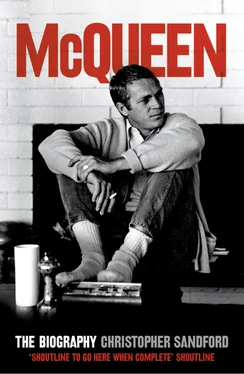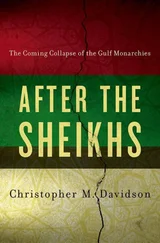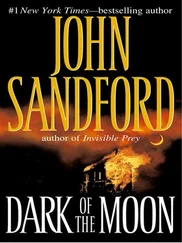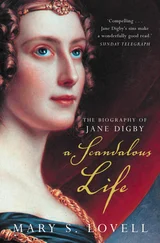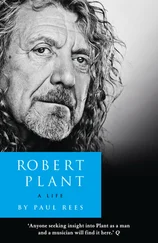Later that same night there was a knock at Neile’s apartment door. It was Steve. She said, ‘I’m going to crash.’ Then he said, ‘Yeah, I am too.’ He couldn’t learn to clean and would sooner starve than cook but he did, nonetheless, light up that small, cluttered bedroom.
‘Boy,’ says Neile, ‘was I happy.’
He was disguised, veiled, going through social motions; she was enjoying herself, displaying what she was, opening herself up to immediate experience. One was playing for time, the other was full of life for the moment. A koala and a leopard, they somehow found themselves on the same limb of the tree. Sure enough, Neile joined the long list of lovers, though for once Steve, radically for him, was on turf well beyond what Benning calls ‘Olympic screwing’. After exactly a week he moved into Neile’s digs at 69 West 55th Street. McQueen arrived carrying a battered suitcase full of old clothes, his crash helmet and the barbells. As Neile says, ‘The man was obviously used to travelling light.’
That September, once fired from Hatful , Steve took off on his new BSA through Florida and, from there, to Cuba. The ominous signs of revolution were already brewing when McQueen got himself arrested for selling yanqui cigarettes in a bar. On 3 October 1956 Neile was handed a telegram at her hotel in Hollywood, where she was then testing for Bob Wise’s film This Could Be the Night :
I LOVE YOU HONEY SEND ME MONEY LET ME KNOW WHATS HAPPENING IN CARE OF WESTERN UNION CON AMOR
ESTEBAN
The central theme of all McQueen’s adult relationships – that contempt for those who caved to him had its parallel respect for those who didn’t – was quickly brought home when Neile turned him down. Steve limped back to West 55th, having sold most of his clothes and cannibalised the BSA for bail, with the words: ‘It’s all right, baby. I admire your spunk.’ Then he sought out a jeweller friend in the Village and talked him into designing a twisted molten gold ring for $25 down and eight further quarterly instalments. Two years later Neile herself finally paid off the balance.
Steve, who had an instinct for reality, would remember the shabbier details of the next month all his life: the ‘dark pit’ when Neile returned to California to film This Could Be the Night , the two or three now suddenly tacky ‘honkings’ behind her back, the constant trickling rain of New York, the flow of reverse-charge calls to the coast; and finally, the guilty sale of Uncle Claude’s watch to raise funds. McQueen himself arrived in California on the morning of 2 November 1956. Bob Wise recalls ‘the kid from Somebody suddenly holed up with Neile in the hotel. Fair enough, but when he also hung around the lot, I had him barred.’ As Wise saw it, despite her own rough knocks, ‘the girl in my movie was young and impressionable’, and McQueen, a hard man to resist, had definitely hustled her. Her manager Hillard Elkins remembers ‘Neile asking my advice, and me telling her she was being a shmuck. In those days, I didn’t know McQueen as an actor. What I did know was that he screwed anything with a pulse, and I thought he was wrong for her.’ On the other hand, Neile and Steve had a peculiarly dire family past in common. They’d already bonded with each other’s mothers in New York. Carmen Adams took to him as one orphaned, deprived, too thin (if sadly lacking in manners) and fed him on nourishing Spanish dishes. McQueen had also introduced his fiancée to Julian, whom she liked. ‘Whatever she’d done or hadn’t done for Steve, as a woman I empathised,’ Neile says today. ‘When she had him, she’d only been a kid herself, trying to find her way in the world.’ The Adamses, too, had had troubles at home. ‘It was two damaged birds flocking together,’ says Neile. ‘Plus, I really loved the man.’
That same Friday night Steve and Neile climbed into a rented Ford Thunderbird, waved to the film crew and headed for the border. The two lapsed Catholics decided on a whim to marry in the mission at San Juan Capistrano, twenty miles south of LA. When that was vetoed by the nuns on the unanswerable grounds that no banns had been published, McQueen exploded. For a while back there, courting Neile, he’d been fine. His truncated vocabulary and make-do syntax had both risen to the occasion. But now he had a schedule to keep. Fuck the banns. Nor were anxieties about the ‘young people’s’ piety misplaced. ‘Open a vein,’ McQueen snarled, and took off again in a crunch of gravel. A few miles further down the coast the now fugitive couple were stopped by the police for speeding. What followed was a scene at the very edge of a Chaplin skit as the law, once briefed by Steve, hurriedly escorted them to a local Lutheran minister. The McQueens were duly married, just before midnight, in a small chapel in San Clemente. The legal witnesses were the highway patrolmen who had pulled them over an hour earlier. ‘It was far out,’ Steve recalled. ‘Here we were getting hitched, and these two big cops with their belted pistols an’ all. Felt like a shotgun wedding.’ By now he’d known his wife for just over three months.
The man Neile Adams married was as gritty as a half-completed road. McQueen wasn’t yet the popular notion of the alpha male – the ape who gets to have sex with all the females and swagger past the competition – but he was getting there, fast. Neile remembers that he rarely or never had any money, gobbled down his food and had a fondness for both Old Milwaukee beer and pot. Steve was ill-read, indeed semi-literate (his next wife famously complained that he couldn’t spell the word ‘blue’). As for social graces, he didn’t overdo them. When Elkins invited him to lunch in the Polo Lounge, McQueen gazed dolefully at the French menu before finally asking if he might be allowed a burger and a shake. He did, however, Neile saw, have that much rarer thing – instinct. ‘Steve could always tell the very few good guys from the phony.’ As the nuns had rightly feared, he wasn’t religious. Besides Neile, McQueen’s sustaining love was of machines, and for him happiness – its possibility and reality, its attainment and capture – came out of a finely tuned call-and-response with the internal combustion engine, the channelling of some great unknown, copulating force that called for the perfect alignment of man and motor. ‘A good set of wheels gets me hard ,’ he’d say. In a race, Steve always felt that his own car, like a woman, was personally challenging him.
His competitiveness! No one who knew McQueen ever forgot it. The actor Dean Jones saw the classic, turbo version of it around the late 1960s. ‘Steve and I used to go biking, and he couldn’t stand – I mean he pathologically hated – being second. The reason McQueen got in so many wrecks is that, good as he was, he overcooked it.’ A charger, in race lingo. No piss-ant limits, he always said, for him. Stirling Moss, one of the few men Steve deferred to on four wheels, encountered the same thing whether on the track at Sebring or driving the canyon roads of Bel Air. ‘McQueen was fast, but he was also undisciplined. My God, the fearlessness of the man. But that was his whole life.’ Sure enough, Steve offered continual homages to ‘mud’ both on and off the screen. He’d already lived too long with the rules and restrictions which pettily obstructed his happiness. Far too fucking long. McQueen ‘constantly had to be proving himself,’ notes Neile. It was the same whether at poker, pinball, sex, fighting or acting. ‘You didn’t win, he did.’ No doubt it was this ‘madness and fire’ that led men like the director Buzz Kulik to portray the Steve of 1956 as a ‘little shit’. A perceptive friend noticed that he ‘was never difficult with people he didn’t like, the people he didn’t take seriously. He was the world’s most charming guy to waiters. On the other hand, he fell out at one time or another with almost all his cronies.’ To Dean Jones, ‘Steve’s film career made a virtue out of his flaws as a man. For me, he had the edge and frenzy of genius.’
Читать дальше
